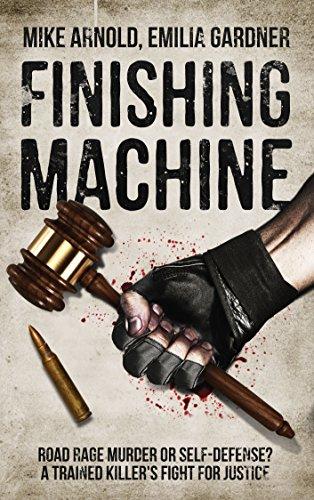The Finishing Machine
By Mike Arnold and Emilia Gardner
$12.98 for 362 pg. paperback
$4.99 for 425 page eBook at Amazon.com
Reviewed by Gila Hayes
I usually enjoy a compelling story without getting so engaged that it keeps me from my sleep. Not so in July, when I read attorney Mike Arnold’s true story about defending an unusual client charged with murder. It was all too easy to imagine one of us caught up in a similar maelstrom!
On a late January evening in 2014, a 30-something military veteran, Blackwater contractor and martial artist shot an unarmed 53-year old man after a road rage collision. The shooter, Gerald Strebendt, was not arraigned until March 7, then spent over a year in solitary confinement in the Lane County, OR jail awaiting trial before pleading to a reduced charge in May of 2015.
His attorney and this book’s author, Mike Arnold quotes Strebendt’s report at their initial meeting. “There’s a car in front of me. It slams on its brakes. I swerve around him to the right to avoid the collision. Before I can do anything he revs up and hits my truck. I’m in shock. He just hit my brand new truck. I can hear him yelling. He is threatening me. I can’t start my truck. So I grab my gun and get out. I call 911. While I’m talking to the operator he keeps coming toward me. He sees my weapon. He says he’s got a gun, too. I back up, telling him to stay away. But he keeps coming. He doesn’t stop. I’m fearing for my life. So I pull the trigger. And he goes down.”
The attorney was interested in the case for “the chance to participate in a community discussion about an issue I cared a lot about: the constitutional right to bear arms…I believe the right to bear firearms goes hand in hand with a person’s natural right to self-defense,” he introduces.
Although Arnold recalls that his client looked, “Like any average guy who was beginning to soften with age,” Strebendt’s defense was complicated by people who attested that he was hotheaded with a mixed martial arts background. A jury would want to know why he didn’t just drive away, why he grabbed a rifle and why he didn’t resist physically instead of shooting the man who assailed him at night on a wet Springfield, OR roadway.
Arnold knew he needed to humanize his client and stifle gossip about him. That meant Strebendt had to admit to character flaws, brushes with the law, and unhappy family history. Establishing the truth was paramount, but since the client had not yet been charged, the defense couldn’t access evidence gathered at the scene. Crucial evidence the police missed would soon vanish in the winter rains, so he quickly hired an investigator and a forensic accident reconstructionist.
That was just the first in a long line of experts. Arnold would later hire experts in use of force, memory, mental health and what could be seen in dark, rainy conditions while looking into headlights. The jury would have to decide, “how reasonable or unreasonable it was for Gerald to make the final decision to fire. They would make their judgments by examining every action or inaction, anything that preceded the shot. Given that [the aggressor] was ultimately found to have been unarmed–despite telling Gerald he had a gun and intended to kill him–we needed to be able to convincingly explain Gerald’s threat assessment process. And to do that, we needed to show the jury how to scientifically examine, analyze and support not just what Gerald saw, but what his brain told him to do about it.” Arnold even found an expert to explain “touch DNA” confirming that the aggressor grabbed for the client’s rifle. It all cost money and he remembers, “I told Gerald he could rest assured that as long as he wanted me, he had me for the duration,” even if that meant low hourly pay if the state found the client indigent and unable to afford representation on his own.
Arnold decided to have his client examined by a polygrapher, not for use in court, but because a passed test would help “persuade the prosecution to do the right thing and slow down or even stop the investigation,” as well as educate reporters and aid fund raising. “Defending a murder charge all the way through trial would cost exponentially more than all the money and assets Gerald owned,” the attorney explains. “Friends and family would be more likely to support a loved one that they believe in.”
Unfortunately, the test was inconclusive, although the polygrapher, an experienced now-retired-law enforcement pro said the interview convinced him personally that the client told the truth.
The prosecutor refused to share the 9-1-1 recordings prior to convening a Grand Jury. The D.A.’s witnesses had reviewed the recordings, but defense was denied this and other reports. Although he’d been initially inclined to recommend that his client testify before the Grand Jury, as the case became increasingly politicized, Arnold had to advise against it. When the prosecution is convinced they can convict the client of a crime, the defense cannot rely simply on the unadorned truth to keep the client out of prison, he opines.
The Grand Jury indicted Strebendt. The law firm now received access to evidence supporting the state’s case. Included were many allegations of past bad deeds, especially road rage, “Since the standard of self defense is what a reasonable person in Gerald’s position would do, his history and temperament, for better or worse, mattered.”
Both sides had issues. Investigators discovered that the aggressor had started drinking at 4 p.m. on the day of the shooting, and bartenders remembered serving him eight 16-ounce beers. The medical examiner “reported a blood alcohol content (BAC) of 0.15 percent at the time of death. That’s almost twice the legal limit in Oregon of 0.08 percent,” Arnold cites. Blood and urine testing showed extreme levels of a drug prescribed for depression and anxiety. An expert reported aggressive behavior, hallucinations and agitation are side effects of exceeding the recommended dosage.
Despite evidence indicating that the defendant shot in self defense, too many other witnesses asserted that in the past they had seen him exhibit road rage, violent behavior and aggression. Conversely, Arnold had plenty of first hand reports of his generosity and kindness to offset the many conflicts that had arisen over the years when the defendant challenged what he saw as bad behavior, creating the impression that he was a bully.
The attorney’s concern grew as bail hearings and other court proceedings became increasingly politicized. He continued to file motions to establish a record of bias, but knew they’d be denied. The judge imposed a broad gag order preventing the defense team from reaching witnesses and countering falsehoods through the news and social media.The law firm filed a writ of mandamus with the Oregon Supreme Court asking for relief from the gag order, but it was denied, so they went low-tech with roadside signs asking anyone with information to phone in. “The media reported it and we got dozens of calls from people who were onsite before, during and after the shooting,” Arnold reports.
The defendant had been incarcerated for over a year and the trial was postponed for nearly another year while the trial judge dithered, waiting for the OR Supreme Court to rule on another case about admissibility of prior bad acts before deciding what she would allow in Strebendt’s trial. The attorney suggested a conference to discuss settlement that resulted in a plea to criminally negligent homicide. The settlement judge imposed his own conditions instead of neutrally guiding both sides to agreement. “Clearly, he (and probably the D.A.) didn’t want to look ‘soft on crime’ by cutting what some would consider a pretty sweet deal,” Arnold opines.
Demoralized by months of solitary confinement, his defense thwarted at every step, the defendant chose the known outcome of a plea agreement. Arnold remembers him saying, “They’ve set me up to be demoralized and desperate to leave this place. Well, it’s worked. I’d rather plead guilty and do a few years than risk spending the rest of my life, or even another year until my trial.” He served the remainder of his sentence at a regional prison, under better conditions.
The attorney and client remained in contact and it proved a time of introspection for both. In a different time, the client might have lived his whole life without being called to account for his confrontational ways. The attorney opines that people he had confronted “did not forget him. When the media caught wind of the shooting, these individuals made the decision to contact law enforcement about their run-ins with Gerald,” adding that now days, “people can participate in not just the conversation about a crime, but also its prosecution.” How ironic that the client’s many good acts were eclipsed by his misdeeds!
While the book gave insight into defending a murder case, my biggest take away is this: Actions required in an emergency will be judged by how we have lived day-to-day long beforehand. Mike Arnold’s book provided much to ponder. I recommend it to members.
To read more of this month's journal, please click here.
